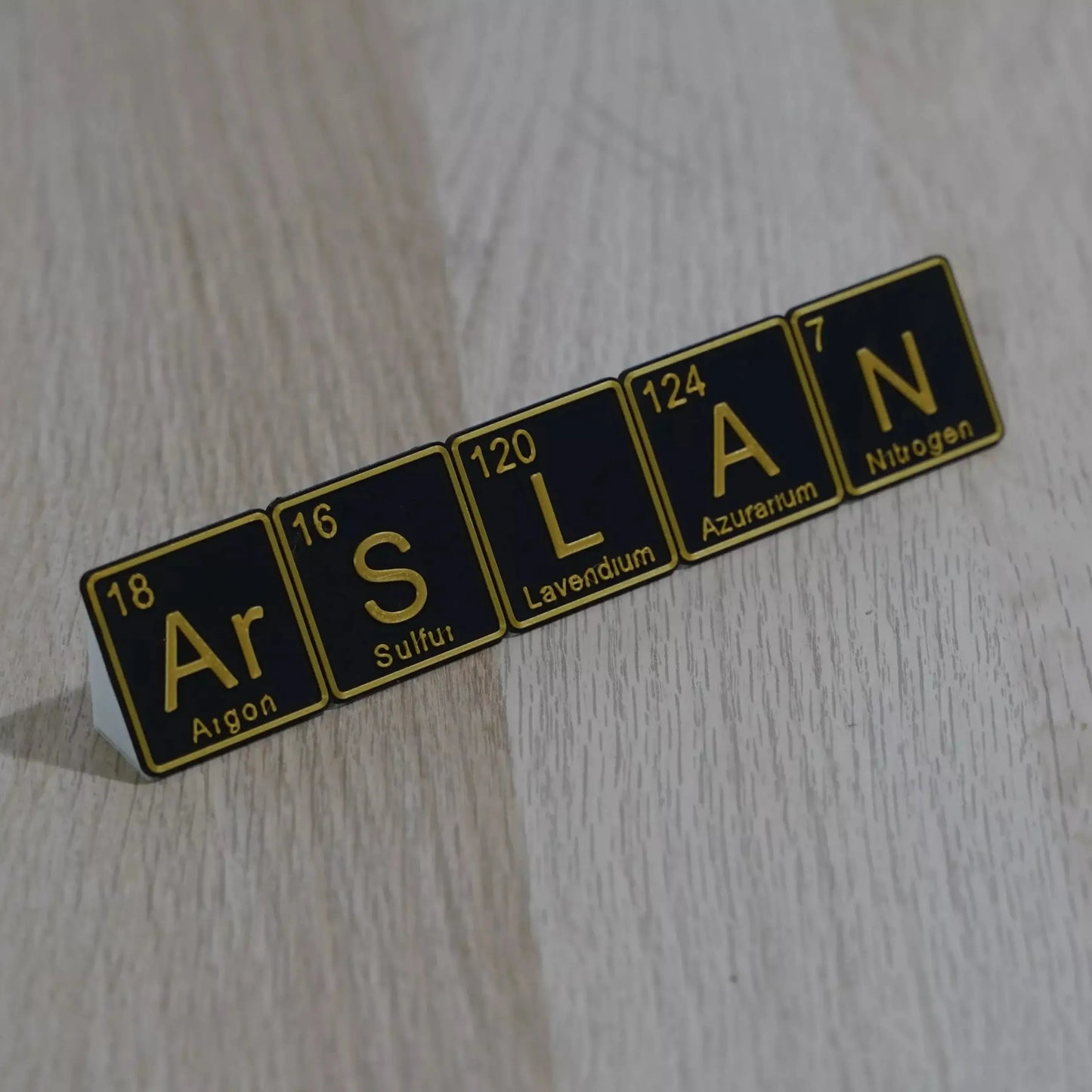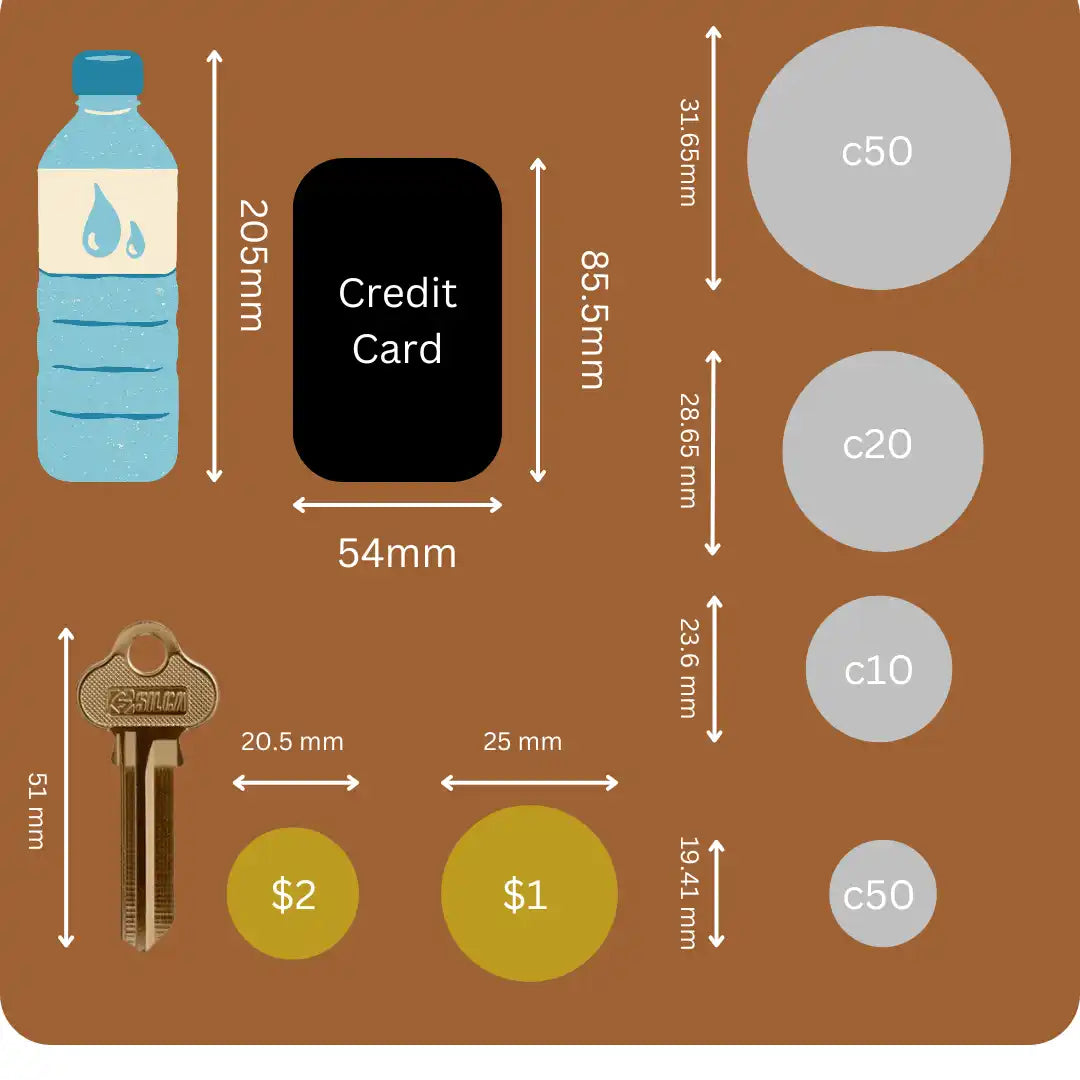


Product Information
Why Choose a Personalised Periodic Name Plate?
Overview:
Make a bold, geek-chic statement with our Personalized Periodic Table Desk Name Plate. This one-of-a-kind display takes inspiration from the classic periodic table, using both real and fictional elements to spell out names, nicknames, or even custom phrases. Whether for science lovers, teachers, students, or office professionals, this personalized name plate is a perfect conversation starter and unique desk accessory.
Features:
- Tile Dimensions: Each tile measures 40mm x 40mm, creating a clean and proportional layout.
- Custom Combinations: Real elements like "H" for Hydrogen or "C" for Carbon are paired with fantasy elements like "G" for Graphitium or "Ez" for Element Zero to accommodate any name or word.
- Maximum Name Length: Up to 7 tiles on a single plate; longer names are supported by joining two plates with a back support.
- Durable & Stylish: Made with high-quality materials for a sleek, professional finish.
- Perfect Gift Idea: Ideal for birthdays, graduations, or office décor for science enthusiasts and creative professionals.
How It Works:
Your name or phrase is broken down into individual elements, with each letter or symbol corresponding to either a real or fictional element. This ensures that every name or phrase can be represented, even if no real periodic table element exists for a specific letter or symbol.
Using the Elements:
Below is how our elements are used to construct your name or phrase:
-
Real Elements (Standard Periodic Table):
Examples include "H" for Hydrogen, "O" for Oxygen, and "Fe" for Iron.
Example: The name "Alex" would use the following elements:- Al (Aluminum)
- Xe (Xenon)
-
Fictional Elements (For Uncommon Letters):
For letters or symbols not in the standard periodic table, we use custom fantasy elements.- "G" for Graphitium
- "J" for Jaffeitium
- "Ez" for Element Zero (a replacement for space or special needs)
Example: The word "Joan" would use:
- J (Jaffeitium)
- O (Oxygen)
- A (Azurarium)
- N (Nitrogen)
Customisation That Speaks to You
A personalised periodic name plate is more than just a wall hanging; it’s an expression of individuality. Because each piece can be tailored to include your name or initials within the periodic table structure, you get something truly one-of-a-kind. But what makes this even better is that the process allows for creativity in colors and styles, so it fits perfectly into any room's theme.
Perfect for Science Lovers and Beyond
If you or someone close to you loves science, then this decorative item will resonate deeply. However, its appeal doesn’t stop there—it works equally well as art in modern or minimalist spaces. So whether you're decorating a child’s bedroom or updating a living area, this name plate adds both personality and sophistication.
Durable Quality Meets Stylish Design
Because these plates are crafted using high-quality materials, they last long while maintaining their vibrant appearance. Moreover, the attention to detail ensures every element aligns flawlessly with the overall aesthetic. As a result, you receive not only a functional piece but also a conversation starter that enhances any environment.
Full List of Elements and Names
The periodic table begins with Hydrogen (H, 1) and Helium (He, 2), followed by Lithium (Li, 3) and Beryllium (Be, 4). Moving forward, we find Boron (B, 5), Carbon (C, 6), Nitrogen (N, 7), Oxygen (O, 8), Fluorine (F, 9), and Neon (Ne, 10). The next elements are Sodium (Na, 11), Magnesium (Mg, 12), Aluminium (Al, 13), Silicon (Si, 14), Phosphorus (P, 15), Sulfur (S, 16), Chlorine (Cl, 17), and Argon (Ar, 18). The list continues with Potassium (K, 19), Calcium (Ca, 20), Scandium (Sc, 21), Titanium (Ti, 22), Vanadium (V, 23), Chromium (Cr, 24), Manganese (Mn, 25), Iron (Fe, 26), Cobalt (Co, 27), Nickel (Ni, 28), Copper (Cu, 29), and Zinc (Zn, 30). Following these are Gallium (Ga, 31), Germanium (Ge, 32), Arsenic (As, 33), Selenium (Se, 34), Bromine (Br, 35), and Krypton (Kr, 36). The sequence continues through Rubidium (Rb, 37), Strontium (Sr, 38), Yttrium (Y, 39), Zirconium (Zr, 40), Niobium (Nb, 41), Molybdenum (Mo, 42), Technetium (Tc, 43), Ruthenium (Ru, 44), Rhodium (Rh, 45), Palladium (Pd, 46), Silver (Ag, 47), and Cadmium (Cd, 48).
The progression moves through Indium (In, 49), Tin (Sn, 50), Antimony (Sb, 51), Tellurium (Te, 52), Iodine (I, 53), and Xenon (Xe, 54). Next come Caesium (Cs, 55), Barium (Ba, 56), Lanthanum (La, 57), and the lanthanides: Cerium (Ce, 58), Praseodymium (Pr, 59), Neodymium (Nd, 60), Promethium (Pm, 61), Samarium (Sm, 62), Europium (Eu, 63), Gadolinium (Gd, 64), Terbium (Tb, 65), Dysprosium (Dy, 66), Holmium (Ho, 67), Erbium (Er, 68), Thulium (Tm, 69), Ytterbium (Yb, 70), and Lutetium (Lu, 71). The sequence continues with Hafnium (Hf, 72), Tantalum (Ta, 73), Tungsten (W, 74), Rhenium (Re, 75), Osmium (Os, 76), Iridium (Ir, 77), Platinum (Pt, 78), Gold (Au, 79), Mercury (Hg, 80), Thallium (Tl, 81), Lead (Pb, 82), Bismuth (Bi, 83), Polonium (Po, 84), Astatine (At, 85), and Radon (Rn, 86).
Moving into the heavier elements, we find Francium (Fr, 87), Radium (Ra, 88), Actinium (Ac, 89), Thorium (Th, 90), Protactinium (Pa, 91), Uranium (U, 92), Neptunium (Np, 93), Plutonium (Pu, 94), Americium (Am, 95), Curium (Cm, 96), Berkelium (Bk, 97), Californium (Cf, 98), Einsteinium (Es, 99), and Fermium (Fm, 100). The list continues with Mendelevium (Md, 101), Nobelium (No, 102), Lawrencium (Lr, 103), Rutherfordium (Rf, 104), Dubnium (Db, 105), Seaborgium (Sg, 106), Bohrium (Bh, 107), Hassium (Hs, 108), Meitnerium (Mt, 109), Darmstadtium (Ds, 110), Roentgenium (Rg, 111), Copernicium (Cn, 112), Nihonium (Nh, 113), Flerovium (Fl, 114), Moscovium (Mc, 115), Livermorium (Lv, 116), Tennessine (Ts, 117), and Oganesson (Og, 118).
The list then moves into fictional elements: Graphitium (G, 119), Lavendium (L, 120), Turquoisium (T, 121), Quartzite (Q, 122), Diamonite (D, 123), Azurarium (A, 124), Emeraldine (E, 125), Jaffeitium (J, 126), Magnitium (M, 127), Xanthosium (X, 128), Rhodizite (R, 129), Zirkozium (Z, 130), followed by numbered elements Onedinium (1, 131), Duonide (2, 132), Threenium (3, 133), Fourthium (4, 134), Fifthium (5, 135), Sixthium (6, 136), Sevenide (7, 137), Eightium (8, 138), Ninethium (9, 139), and Nulimium (140). The list concludes with more fictional elements: Element Zero (Ez, 141), Space (, 142), Punctium (., 143), Questionide (?, 144), Exclimion (!, 145), Pluzircium (+, 146), Minumium (-, 147), Unobtainium (Un, 148), Mithril (Mi, 149), Dragonautium (Dr, 150), Prusarium (Pr, 151), Bugattium (Bu, 152), Stauroline (St, 153), and Kryptonite (Kr, 154).
Height (H) mm
Width (W) mm
Length (L) mm
Depth (D) mm
Keep Cool: Avoid high temperatures (above 50°C) to prevent warping.
Gentle Cleaning: Use mild soap and cold water; avoid hot water and dishwashers.
Handle with Care: PLA can be brittle; avoid dropping or applying too much force.
Store Properly: Keep in a cool, dry place, out of direct sunlight.
Limit Sun Exposure: For outdoor use, apply a protective coating to prevent UV damage





